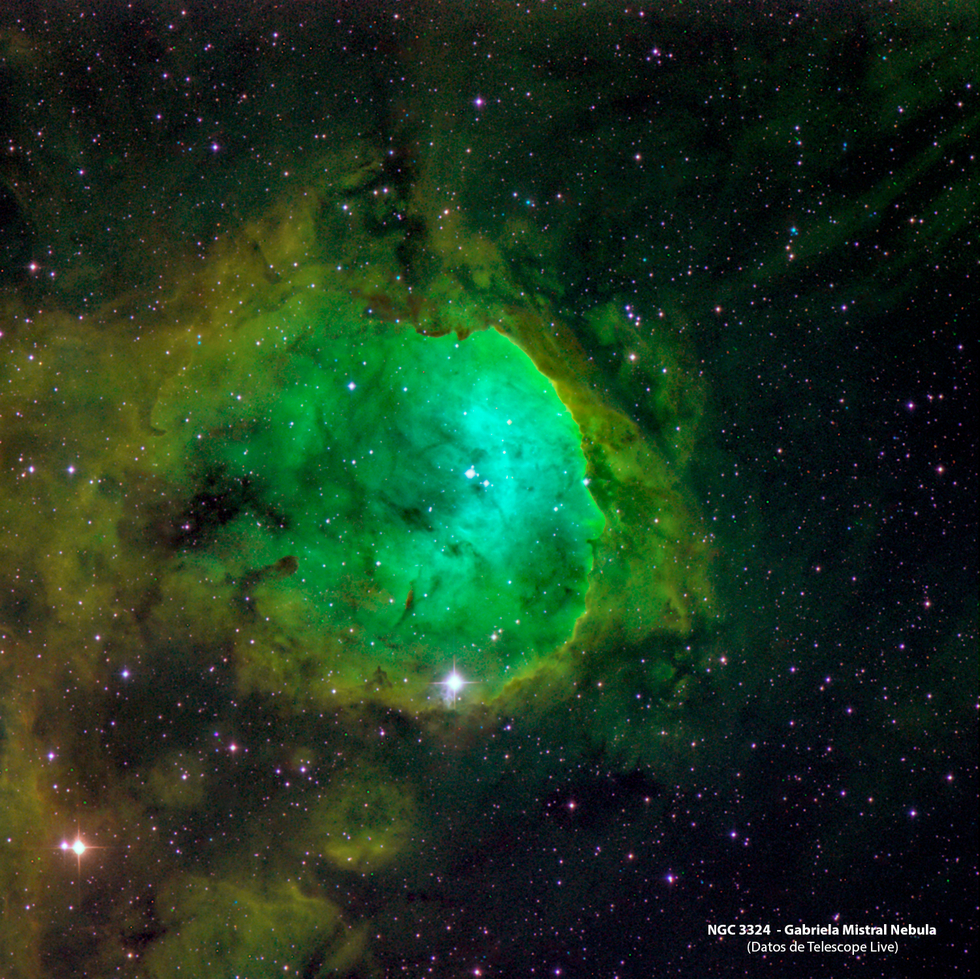NGC3324 - The Gabriela Mistral Nebula. Palette SHO
NGC3324 - The Gabriela Mistral Nebula. Palette SHO
NGC 3324 is located in the southern constellation of Carina (The Keel, part of Jason’s ship the Argo) roughly 7500 light-years from Earth. It is on the northern outskirts of the chaotic environment of the Carina Nebula, which has been sculpted by many other pockets of star formation (eso0905). A rich deposit of gas and dust in the NGC 3324 region fuelled a burst of starbirth there several millions of years ago and led to the creation of several hefty and very hot stars that are prominent in the new picture.
Stellar winds and intense radiation from these young stars have blown open a hollow in the surrounding gas and dust. This is most in evidence as the wall of material seen to the centre right of this image. The ultraviolet radiation from the hot young stars knocks electrons out of hydrogen atoms, which are then recaptured, leading to a characteristic crimson-coloured glow as the electrons cascade through the energy levels, showing the extent of the local diffuse gas. Other colours come from other elements, with the characteristic glow from doubly ionised oxygen making the central parts appear greenish-yellow.
As with clouds in the Earth's sky, observers of nebulae can find likenesses within these cosmic clouds. One nickname for the NGC 3324 region is the Gabriela Mistral Nebula, after the Nobel Prize-winning Chilean poet [1]. The edge of the wall of gas and dust at the right bears a strong resemblance to a human face in profile, with the "bump" in the centre corresponding to a nose.
Stellar winds and intense radiation from these young stars have blown open a hollow in the surrounding gas and dust. This is most in evidence as the wall of material seen to the centre right of this image. The ultraviolet radiation from the hot young stars knocks electrons out of hydrogen atoms, which are then recaptured, leading to a characteristic crimson-coloured glow as the electrons cascade through the energy levels, showing the extent of the local diffuse gas. Other colours come from other elements, with the characteristic glow from doubly ionised oxygen making the central parts appear greenish-yellow.
As with clouds in the Earth's sky, observers of nebulae can find likenesses within these cosmic clouds. One nickname for the NGC 3324 region is the Gabriela Mistral Nebula, after the Nobel Prize-winning Chilean poet [1]. The edge of the wall of gas and dust at the right bears a strong resemblance to a human face in profile, with the "bump" in the centre corresponding to a nose.
SPECIFICATIONS
Telescope
Planewave CDK24
Camera
FLI ProLine PL9000
Location
Río Hurtado, Coquimbo Region, Chile
Date of observation
29/10/2020
Filters
H alpha, OIII & SII
Processing
DSS & Photoshop
Credits
Pro Dataset


